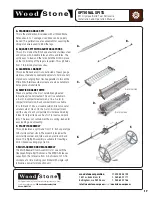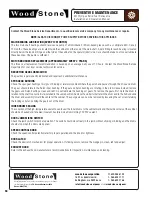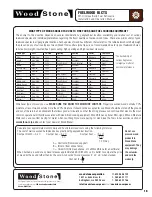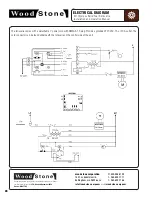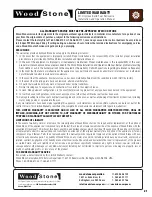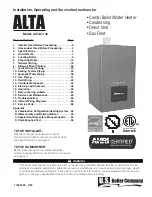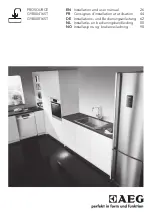
10
Mt. Olympus Solid Fuel Rotisserie
Installation and Operation Manual
VENTING
An ongoing program of product improvement may require us to change
specifications without notice.
SFR, Revised November 2014.
Doc no: M0057.02
info@woodstone-corp.com
or visit
woodstone-corp.com
wood stone corporation
1801 w. bakerview rd.
bellingham, wa 98226 usa
tf. 800.988.8103
t. 360.650.1111
f. 360.650.1166
VENTING
The hood and ductwork used to vent the Mt. Olympus rotisserie must be manufactured and installed in accordance with national and
local code requirements for solid-fuel broilers. This appliance must be vented with a Listed Type 1 exhaust hood or one constructed
and installed in accordance with NFPA 96.
As with all solid fuel cooking equipment and exhaust systems,
a regular inspection and cleaning schedule is needed to prevent
the possibility of fire.
The frequency of inspection and cleaning will depend on hours of use and type and quality of fuelwood.
Typically solid fuel installations will require cleaning and inspection at least monthly.
CREOSOTE: FORMATION AND NEED FOR REMOVAL
Creosote should be removed to reduce risk of fire. When wood is burned slowly, it produces tar and other organic vapors that
combine with expelled moisture to form creosote. The creosote vapors condense in a relatively cool oven flue and exhaust hood of a
slow burning fire. As a result, creosote residue accumulates on the flue lining and exhaust hood. When ignited, the creosote makes
an extremely hot fire. The oven flue should be inspected twice monthly to determine when creosote build up has occurred. When
creosote has accumulated, it should be removed to reduce risk of fire.
CALL WOOD STONE FOR INFORMATION AND INSTALLATION SPECIFICATIONS
ON GAYLORD HOODS, DESIGNED SPECIFICALLY FOR THE MT. OLYMPUS ROTISSERIE.

















